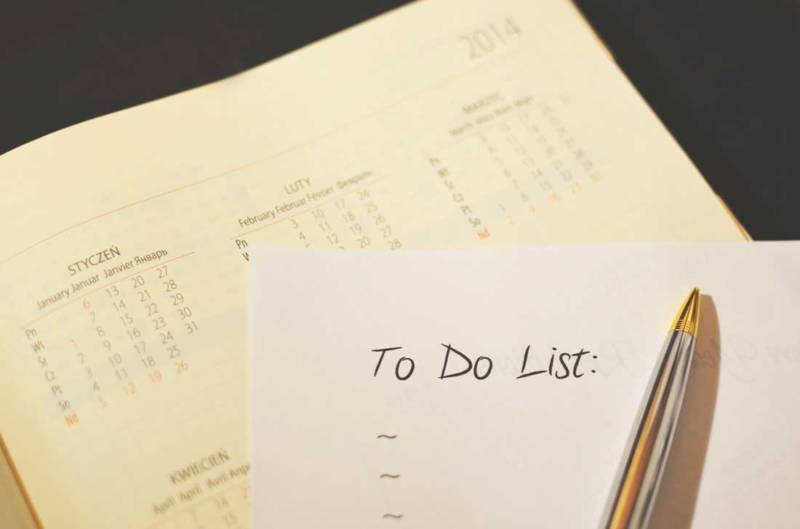
Now that you’ve learned to find and think through stressors in your school, work, and personal life, it’s time to learn about the tools to conquer and harness stress. Because unwanted stress reactions affect both our minds and our bodies, a good way to defeat stress must also use both our minds and our bodies. The best way to conquer stress is to use these six tools:
- Getting Organized
- Affirmative or Positive Thinking
- Taking Charge
- Relaxing
- The Relaxation Response
- Taking Care of Your Body
Let’s look at each of these tools to conquer and harness stress in more detail.

Getting Organized
Feeling a sense of control over your life is very important in stress and anxiety management. One of the first steps in gaining a sense of control in your life is to get organized. A cluttered and disorganized life leads to a stressful life. It also prevents you from managing your time. To get organized means to get rid of the clutter around you that stops you from reaching your daily goals. Whether it is getting to school or work on time, completing a big project, or just finding time to relax and unwind, the clutter in your life can stop you cold.

Affirmative Thinking
You have learned that destructive or harmful beliefs and negative self-talk help create your stress. These stress-creating ways of thinking are not good habits. A habit is a way you do something that you have done so often or for so long that you do it without thinking. Luckily, habits can be changed. When you change your bad habits, you will have less stress and anxiety.
Replacing a harmful belief with an affirmative or positive one can be done by following a three step process. Keep in mind that changing a habit takes a lot of work. In order to unlearn a harmful belief and replace it with an affirmative one, you must be willing to work toward a goal every day for several weeks. Once you make this commitment or promise to yourself, your chances of success increase greatly.
Taking Charge
Many of the unwanted stress reactions come from Control Myopia. Either you feel you must control events or you believe that the events will control you. The truth is, there are some things you can control and others you cannot. A great deal of stress in our lives can be pushed aside if you can learn to control the things you can, and let go of things you cannot control. By increasing your skills in the areas of time management, planning, and organizing, you can anxiety-proof a large part of your life.

Relaxing
Relaxation or resting will also help you conquer and harness your stress. It is a good way to stop the cycle of stress build-up in one’s school, work, and personal life. The stress-reducing effect of relaxation improves the way we look at things and makes it easier to practice affirmative thoughts and positive self-talk. And, importantly, it gives us the ability to think clearly and the strength we need to do our best.
The Relaxation Response
The Relaxation Response came from the work of cardiologist Herbert Benson. By having his patients use this natural means for changing their thinking for brief periods, Dr. Benson noted a reduction in stress. This response will help you conquer stress when used for about 15 to 20 minutes each day. It can improve the ability to think clearly and reduce heart and breathing rates, muscle tension, and blood pressure. Long-term use has been shown to improve the body’s immune system (the system that protects the body from disease).
Here’s how to practice The Relaxation Response:
- Sit still in a comfortable position and loosen any tight clothing – especially around your waist.
- Close your eyes. Relax your muscles, starting at your toes and working up through the top of your head. It may help to imagine your body slowly filling up, from toes to head, with warm, heavy, dry sand.
- Focus on your breathing as you breathe through your nose. Say the word “one” to yourself each time you exhale (breathe out). Inhale (breathe in) naturally, using your stomach muscles, and let only the weight of your chest push the air from your lungs.
- Continue this controlled breathing for 15 to 20 minutes. Open your eyes when necessary to check the time. Do not use a timer. When you’ve finished, remain seated for a couple minutes with your eyes closed, then with your eyes open for another few minutes.

Taking Care of Your Body
The link between mind and body cannot be ignored in a stress-reduction program. Each of us, no matter our age or level of fitness, can benefit from a regular fitness program. Before doing so, of course, you should see a doctor to decide what level and type of activities you can do safely.
Once again, it is important to manage your time so you can exercise on a regular basis. Most experts recommend at least three hours of exercise each week. By doing this, you will increase your ability to handle stressful situations and lower your level of anxiety.
Thanks for tuning into our series on teaching stress management to your students. If you want to learn more about developing or teaching soft skills, check out our Success Profiler 4 page brochure here.
